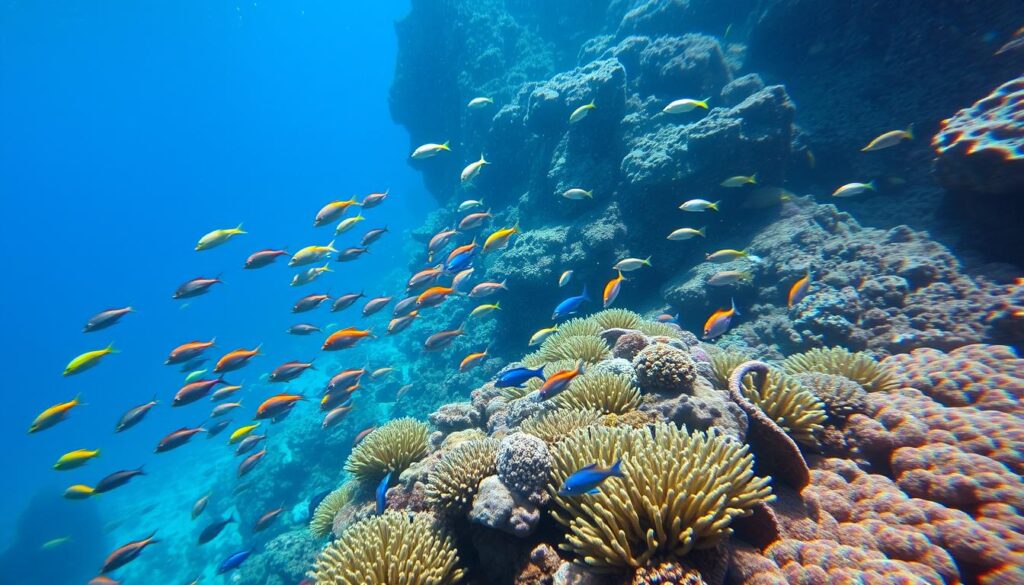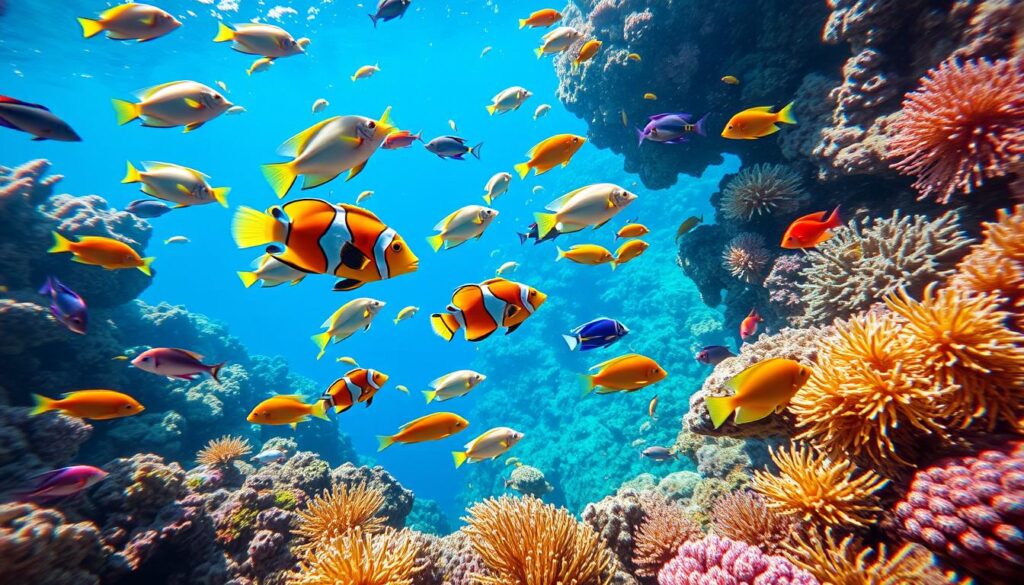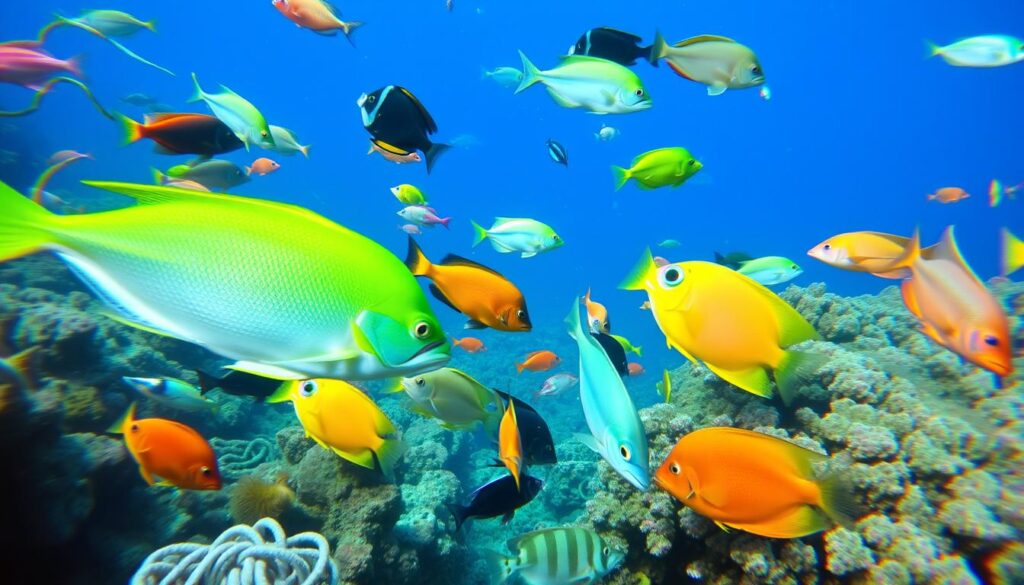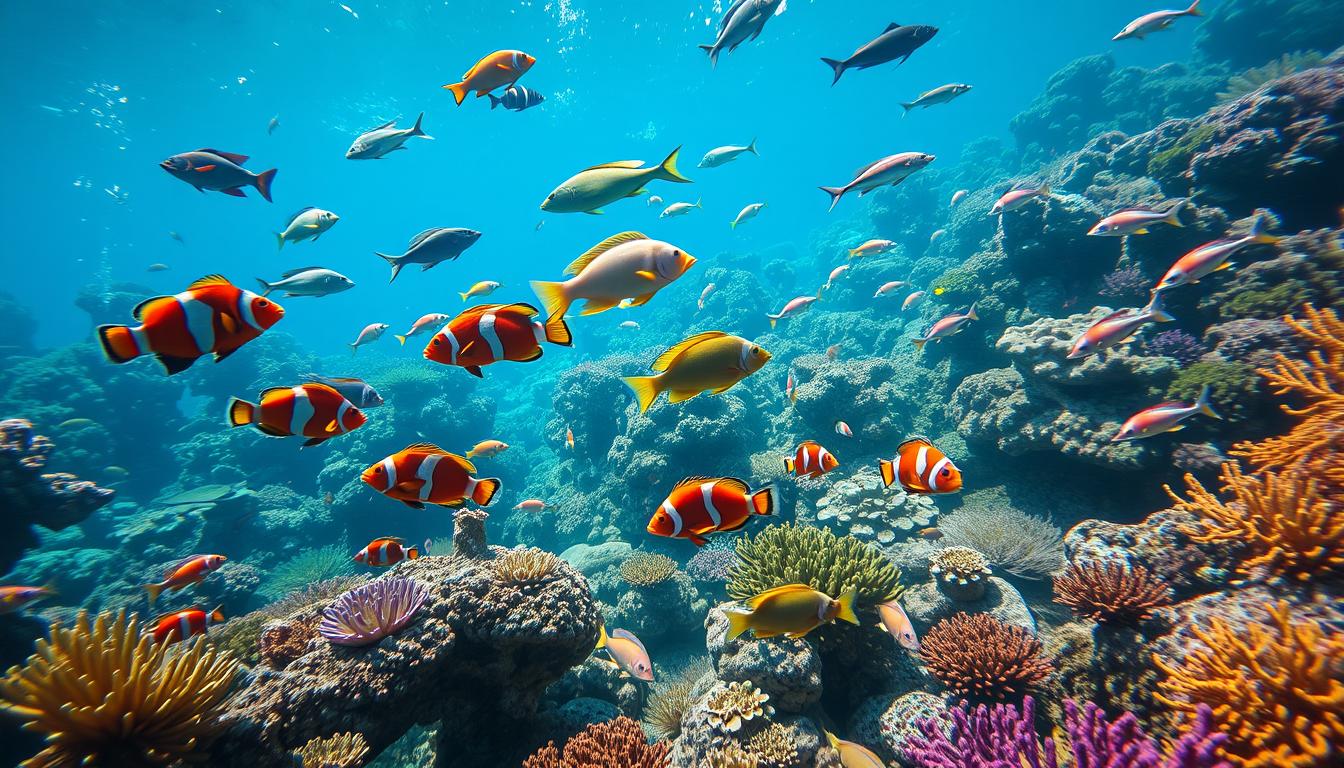Saltwater fish species are key to our planet’s ecosystem, with thousands living in our oceans. It’s important to understand and appreciate them for their conservation and our enjoyment. From clownfish to angelfish, knowing how to identify these fish is crucial for anyone interested in aquariums or marine biology.
These fish are a favorite among aquarium fans and scientists. This guide will help you learn about their unique traits and habitats. By understanding their homes and behaviors, we can appreciate their importance in keeping our oceans healthy.
Exploring saltwater fish species helps us understand their relationships with their environments. From coral reefs to the open sea, these fish are essential for our ecosystem’s balance. By learning about them, we can work to protect these amazing species for the future.
Key Takeaways
- Saltwater fish species are a diverse and vital part of our planet’s ecosystem
- Understanding and appreciating these species is crucial for their conservation
- Saltwater fish identification is an essential skill for aquarium enthusiasts and marine biologists
- Popular saltwater fish like clownfish and angelfish are just a few examples of the thousands of species found in our oceans
- Learning about saltwater fish species can help us gain a deeper appreciation for the importance of these creatures and the role they play in maintaining the health of our oceans
- Saltwater fish species are found in a variety of habitats, including coral reefs and the open ocean
Understanding the Diversity of Saltwater Fish Species
The variety of saltwater fish is both complex and fascinating. Many types of fish live in our oceans. A saltwater fish chart helps us understand these differences. It shows the different species and their traits.
Saltwater aquarium fish are loved by many. Knowing their needs and behaviors is key to a healthy aquarium.
Evolution plays a big role in the variety of saltwater fish. Each species has adapted to its own ocean niche. Some live in shallow coral reefs, while others thrive in the deep sea.
For example, fast-swimming predators like marlin and tuna live in the open ocean. On the other hand, groupers and snappers prefer the bottom.
Marine Fish Classification Systems
Marine fish classification systems group fish into categories. These categories are based on their traits and evolutionary ties. These systems help us understand the diversity of saltwater fish.
They also help aquarium fans learn about their fish. By studying these systems, we can better care for our saltwater aquarium fish.
Geographic Distribution Patterns
The places where saltwater fish live are shaped by many factors. These include water temperature, salinity, and food availability. Each species has found its own home, from the Caribbean’s warm waters to the North Atlantic’s cooler ones.
Knowing where fish live helps aquarium fans create a diverse and realistic environment. It makes their aquariums more interesting and natural.
Essential Characteristics of Marine Fish
Exploring saltwater tropical fish reveals their unique traits. These traits include physical and behavioral aspects. For example, common saltwater fish show bright colors and patterns. These help them communicate and find mates.
A saltwater fish list shows a wide variety of species. Each has special features, like bioluminescence, to live in the tough marine world. Knowing these traits is key for both aquarium fans and scientists. It helps them care for these amazing creatures well.
- Streamlined bodies for efficient swimming
- Specialized fins for maneuverability and balance
- Advanced sensory systems, including lateral lines and vision
These traits help common saltwater fish survive in their homes, from shallow reefs to deep-sea trenches. By studying these traits, we learn more about marine life’s complexity and beauty.
Marine fish have evolved to occupy almost every conceivable niche in the ocean, from the tiny planktonic fish to the massive whale sharks.
As we delve into the world of saltwater tropical fish, we must value their habitats and respect their role in the ocean. This way, we can protect their health and diversity for the future.
Common Saltwater Fish Habitats
Saltwater fish live in many different places, each with its own special features. To learn about these fish, we need to know where they live. It’s important to be able to tell apart the different species found in these places.
Reef environments are home to many colorful fish. These reefs offer a place for fish to hide, eat, and find a mate. On the other hand, pelagic zones are vast open ocean areas where fish like tuna and mackerel swim. Coastal waters, including estuaries and mangroves, also have a wide variety of saltwater fish.
Reef Environments
Reef environments are some of the most diverse places in the ocean. They are home to many saltwater fish, like parrotfish, butterflyfish, and angelfish. These fish have developed bright colors and complex social behaviors to live in the reef.
Pelagic Zones
Pelagic zones are vast open ocean areas with little structure. Yet, they are home to many popular saltwater fish, including tuna, swordfish, and marlin. These fish have strong swimming abilities and advanced senses to survive in the open ocean.

Coastal Waters
Coastal waters, like estuaries and mangroves, offer a special home for saltwater fish. These areas have brackish water, a mix of fresh and saltwater. Knowing how to identify these fish is key, as many species live in these coastal waters, including mullet, snapper, and grouper.
Popular Saltwater Fish for Home Aquariums
Many people love the vibrant colors and variety of saltwater aquarium fish. With the right care, these fish can do well in a home tank. Favorites include clownfish, angelfish, and butterflyfish.
Saltwater game fish are also popular for those with more experience. These fish are bigger and need more care. But, they can be very rewarding in a well-set-up tank. It’s important to know what each fish needs before adding them to your tank.
When picking saltwater tropical fish for your tank, consider a few things:
- Space and swimming needs
- Diet and how to feed them
- If they get along with other fish
Choosing the right saltwater game fish or saltwater aquarium fish can make your tank beautiful and lively. It will also give you lots of joy and interest.
Identifying Saltwater Fish Species in the Wild
Knowing how to identify saltwater fish is key for any marine lover. It doesn’t matter if you’re new or experienced. To spot saltwater fish, look at their looks, how they act, and their colors. A saltwater fish chart or list can really help.
Physical Characteristics
Body shape, size, and fins are key to figuring out a fish’s type. Some have cool stripes or spots, while others stand out with bright colors. For more on setting up a saltwater tank and learning about fish, check out this link.
Behavioral Patterns
How fish swim and act with others can also tell you what they are. Some like to be alone, while others prefer to swim in groups. Watching these behaviors can help you guess what fish you’re looking at.
Color Variations and Patterns
Colors and patterns are big clues too. Some fish are very colorful, while others are more calm. Notice the colors and patterns on the fish’s body. By using all these clues and a fish chart or list, you can get good at finding out what fish you see in the wild.
Tropical Saltwater Fish Care Guidelines
Caring for saltwater tropical fish requires understanding their diet and environment. It’s a challenge, but with the right advice, you can make a great home for your saltwater aquarium fish.
Feeding your saltwater tropical fish a balanced diet is key. Mix high-quality flakes or pellets with live or frozen foods. Also, don’t forget to change the water regularly and use good filters for a healthy home.

- Water temperature: between 72-82°F (22-28°C)
- Water pH: between 8.1-8.4
- Salinity: between 1.020-1.025
By following these tips and doing your homework, you can make a stunning saltwater aquarium fish space. It will bring joy and wonder for hours.
Commercial and Game Fish Species
Saltwater game fish are key to the ocean’s health. Many are caught by both commercial and recreational fishermen. Fish like tuna and swordfish are in high demand, driving big fishing industries.
These fish are crucial for food and for the fun of fishing. They bring in a lot of money and jobs.
Popular game fish include marlin, sailfish, and tarpon. They’re loved for their fight and are often sought in fishing tournaments. Commercial fish like cod, snapper, and grouper are also prized for their taste and texture.
Sport Fishing Favorites
Sport fishing for saltwater game fish is a favorite pastime. Anglers from all over go to catch big fish like blue marlin and yellowfin tuna. The excitement of catching a big fish is a big part of the appeal.
Commercial Fish Species
Commercial fishing for saltwater fish is a big deal. Many countries depend on it for food and jobs. Laws and quotas help keep fish populations healthy and prevent overfishing.
Seasonal Availability
When you can catch certain fish changes with the seasons and where you are. Lobster and crab are more common in some months. Tuna and swordfish are usually available all year. Knowing when fish are in season is key for both commercial and recreational fishing.
Setting Up a Saltwater Aquarium Environment
Creating a thriving saltwater aquarium for fish needs careful thought. It’s key to understand the importance of proper care for your fish. By visiting caring for small pets, you can learn a lot about your aquatic friends.
Water Parameters
Keeping the water right is crucial for your fish’s health. You need to watch the temperature, pH, and salinity levels. Regular water testing is essential for your fish’s well-being.
Equipment Essentials
You’ll need the right equipment for a healthy aquarium. This includes a good filter, protein skimmer, and heating system. The right gear helps keep your fish happy and healthy.
Maintenance Schedule
Keeping up with regular maintenance is key. This means regular water changes, cleaning equipment, and checking water levels. A consistent routine helps your fish thrive.
Feeding and Nutrition Requirements
Proper nutrition is key for saltwater fish health. A balanced diet is crucial for their growth and survival. Knowing what your fish needs is vital for their care.
Different saltwater fish species have unique dietary needs. It’s important to feed them accordingly. A saltwater aquarium fish diet should include both meaty and plant-based foods.

- Offer a varied diet to ensure they get all nutrients.
- Avoid overfeeding to prevent water quality issues and fish stress.
- Watch how much they eat and adjust their diet as needed.
Understanding your saltwater aquarium fish‘s feeding needs is crucial. It helps them thrive in their home.
Common Health Issues and Treatment
Caring for saltwater fish is important. They can get sick, but with the right care, you can prevent this. Keeping their tank clean and healthy is key.
Watching your fish closely is vital. Look for any changes in how they act or look. Signs like trouble breathing or acting tired are red flags.
Disease Prevention
Stopping diseases before they start is crucial. Keep the water quality good, feed them right, and don’t overcrowd their tank. This helps keep them healthy.
Signs of Illness
Knowing when your fish is sick is important. Look for signs like loss of appetite, color changes, and visible injuries. These are signs they need help.
Treatment Options
There are many ways to treat sick fish. It depends on the disease. You might need medicine, change the tank, or keep the sick fish separate.
By following good care tips, you can keep your fish healthy. This way, you can enjoy a vibrant and diverse marine world in your tank.
Breeding Saltwater Fish Species
Breeding saltwater fish can be tough but very rewarding. To succeed, you need to know how they reproduce and what they need. This means creating the right environment, feeding them well, and keeping an eye on the water.
Some saltwater aquarium fish are easier to breed than others. For example, clownfish and damselfish are pretty simple to breed in a tank. But, angelfish and butterflyfish are harder and need special care.
To breed saltwater fish species right, you must give them the best saltwater fish care. This means keeping the water just right, feeding them a variety of foods, and making sure they’re not stressed. By following these steps and doing your homework, you can have a great time breeding saltwater fish.
Here are some tips for breeding saltwater aquarium fish:
- Research the specific breeding requirements for your species
- Provide a suitable environment, including a separate breeding tank
- Monitor water parameters and make adjustments as necessary
- Offer a balanced diet and supplement with live or frozen foods
With patience, dedication, and the right knowledge, you can successfully breed saltwater fish species and enjoy the beauty and diversity of these amazing creatures.
Conservation Status and Environmental Impact
Saltwater fish species face many threats like climate change, habitat loss, and overfishing. The conservation status of many saltwater fish species is a big worry. Some species’ populations are dropping a lot. Saltwater aquarium fish lovers can help by supporting sustainable practices and choosing captive-bred fish.
Several factors harm the conservation status of saltwater fish species, including:
- Habitat destruction and degradation
- Overfishing and bycatch
- Climate change and ocean acidification
Threatened Species
Many saltwater fish species are at risk, like the hawksbill sea turtle and the giant grouper. They need protection and conservation to survive. By practicing sustainable saltwater fish care, we can lessen our impact on these species.
Protection Measures
There are many ways to protect saltwater fish species, like marine protected areas and fishing rules. These efforts help reduce harm to fish populations and support the recovery of endangered species.
Embracing the Marine World: Your Journey with Saltwater Fish
As we wrap up our look at saltwater fish, it’s clear they’re more than ocean dwellers. They show us the health of marine ecosystems. Keeping them safe is key for our aquarium fish and the ocean’s balance.
Your adventure with saltwater fish care can spark wonder and a love for the sea. It can also fuel a drive to protect them. By learning about these amazing creatures, you can help spread the word about their importance.
The ocean is full of wonders, and saltwater fish are at the heart of it all. They show us the beauty and strength of the sea. Let’s keep exploring and caring for these creatures. Together, we can make sure future generations can enjoy the beauty of saltwater fish.
FAQ
What are the most common saltwater fish species?
Common saltwater fish include clownfish, angelfish, and tangs. Also, wrasses, damselfish, and gobies are popular. They are loved for their bright colors and interesting behaviors.
How can I identify saltwater fish species in the wild?
To spot saltwater fish in the wild, look at their body shape and fin placement. Notice their colors and unique markings. Watch how they behave and where they live. A saltwater fish guide can also help.
What are the requirements for setting up a successful saltwater aquarium?
A good saltwater aquarium needs the right water, equipment, and care. You need a cycled tank, good filtration, and the right lighting. Keeping the water temperature and pH stable is key. Regular water checks and upkeep are crucial.
What are the dietary and nutritional needs of saltwater fish?
Saltwater fish need a mix of live, frozen, and flaked foods. This can include shrimp, brine shrimp, algae, and special fish food. A varied diet keeps them healthy.
How can I prevent and treat common health issues in saltwater fish?
Keep the water clean and reduce stress to prevent illness. Watch for changes in behavior or appearance. If your fish gets sick, see a vet or aquarium expert for advice.
What are some popular saltwater fish species for home aquariums?
Home aquarium favorites include clownfish, damselfish, and dottybacks. Gobies, wrasses, and angelfish are also popular. They’re known for their colors and interesting behaviors.
How can I help conserve saltwater fish species and their habitats?
Support sustainable fishing and avoid buying endangered fish. Help protect marine areas. Reduce your environmental impact and support conservation groups.

